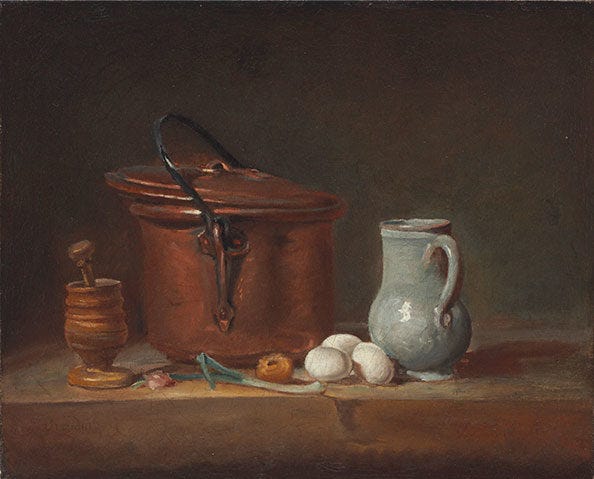Jean-Baptiste-Siméon Chardin's still lifes on beauty in ordinary things
There are traces of human life in Chardin's work which we can derive beauty from, and he asserts the beauty in simplicity and in fulfilling one's purpose.
After four years, I’ll finally be retiring my blog catchinglight.org. The articles I’ve published there will be moved here. This is one of them.
Originally published on September 8, 2017
Portraying inanimate objects and not people, still life ranks the lowest in the hierarchy of genres of established art in 17th century France. Even so, still lifes grew increasingly popular, especially in other parts of Europe as an effect of urbanization. At the time, paintings in the genre either celebrated worldly pleasures or reminded the viewers of the transience of human life.
Jean-Baptiste-Siméon Chardin’s still lifes seem to do both in tempered degrees. Chardin depicts fruits, vegetables, and meat. Yet his tables are often not laden with food and drink, and he places on them objects that have become imperfect from the roughness of everyday use. As for similarities to memento mori, he doesn’t so much depict the brevity of life as he does the brevity of a moment. This is to say there are traces of human life in Chardin’s work which we can derive beauty from. His choice and placement of the objects and how he portrays them allow us to imagine the possible scenes that led to his image before it’s changed by the ones that might follow.

A copper saucepan, a pestle and mortar, pitcher, scallion, eggs and an onion on a shelf shows the said things with some character. Chardin paints a blackening saucepan, an asymmetrical mortar, a graying pitcher, and a floppy scallion. The work hints that the cook was possibly in the middle of gathering ingredients, hence the very bare setup. Even though it’s a still life, the picture is imbued with movement through the pan’s slanted lid and handle, and one of the eggs about to teeter if it weren’t sandwiched by another egg and the pitcher. The cook must have gruffly placed them on the shelf before heading to get the meat, maybe, or bowls, a chopping board, and a knife. It’s interesting too how the pestle isn’t leaning right on the lip of the mortar. There must be ingredients, say, peppercorns, in the mortar, and one can just imagine the cook having poured some into it just moments ago.
Chardin’s The Left Overs of a Lunch is more blatant with the presence of people for showing someone’s leftovers. The silver goblet signifies the person’s wealth, and with it, the possibility of someone else cleaning up after him. Therefore, that these are placed in a niche that could be found anywhere in the house suggests that someone else put them there in the meantime to attend to another matter.
The haphazardly sliced bread, the goblet filled to the brim, and the spoon on the slope of the plate due to a filled dish speak of the person’s lack of appetite and effort to nourish himself. On top of that, the slanted knife recalls the person stabbing the bread, insinuating his foul mood or flippancy.
That we construe scenes or characters from the still lifes shows that everyday objects are extensions of ourselves in that these reveal our interaction with the world and something about us.
The two works are just some of Chardin’s paintings that present domestic life, and by association, human life: We eat, we serve and are served, we create, we get into foul moods.
Still, there’s more to ordinary things apart from how they speak of us and our lives. Chardin shows their beauty best in Glass of Water and Coffee Pot. His styled and contrived composition and his choice of objects let him evoke harmony while still highlighting the distinguishing facet of each.
The painting features the titular vessels, three bulbs of garlic, and an herb. The glass and the coffee pot contrast each other, with one transparent and the other opaque, one expanding upwards, the other downwards. Chardin evokes order and harmony through the side-by-side arrangement: The two vessels vertically divide the frame in half, and the rim of the glass and the handle of the pot divide it horizontally. The right edge of the glass and the left edge of the pot run parallel to each other.
The bulbs of garlic and the herb have nothing gastronomic to do with water and coffee, yet there they are, adding to the contrast and overall harmony. Their whiteness counterpoints the black stains on the coffee pot, their opacity and clarity against the transparency and cloudiness of the glass. The vegetables and the vessels also interact with light differently: the vegetables absorb the light, while the vessels reflect it. The softness of the vegetables, especially the herb, foil the solidity of the glass and the pot.
The sense of comfort and calm that hangs in the air owing to the smooth blending of the paint, the soft lines, and the gentle light that nonetheless casts deep shadows also influences our attitude toward the subject. With it and through the realism in his work, Chardin invites us to fully accept the being used hence the marred glass of water and the coffee pot. The blemishes not just add character or create individuality but also show purpose being fulfilled time and time again.
As viewers, we can take that for what it is or elevate it to a metaphor for ourselves.
Recommended Reads
“Memento Mori,” Tate.
“Still Life,” Tate.
“The Man Who Could Paint Silence,” Richard Dorment. Telegraph. 08 March 2000. Article.
“Chardin’s Austere Brilliance,” Souren Melikian and International Herald Tribute. New York Times. 2 October 1999. Article.





